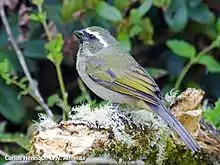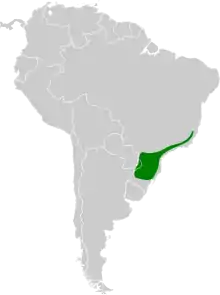Thick-billed saltator
The thick-billed saltator (Saltator maxillosus) is a species of saltator in the family Thraupidae. It is found in highland Atlantic Forest in southeastern Brazil, far northeastern Argentina (only Misiones Province), and perhaps far eastern Paraguay.[1] Unlike most other saltators, it is sexually dichromatic: Females resemble a green-winged saltator, but with a thicker bill, greener face and buff throat. The male thick-billed saltator is unique with its long white eyebrow, grey back, and black and orange beak (amount of orange varies).
| Thick-billed saltator | |
|---|---|
 | |
| Scientific classification | |
| Domain: | Eukaryota |
| Kingdom: | Animalia |
| Phylum: | Chordata |
| Clade: | Dinosauria |
| Class: | Aves |
| Order: | Passeriformes |
| Family: | Thraupidae |
| Genus: | Saltator |
| Species: | S. maxillosus |
| Binomial name | |
| Saltator maxillosus Cabanis, 1851 | |
 | |
Description
Measures about 19 centimeters. It draws attention by the very thick, tall and yellow beak at the base. Upper parts dark gray. Almost without green, white eyebrow starting at the base of the beak, lower parts rusty; female with green back; the immature with green upper parts and the black beak.
Its vocalization is by stanza of four strong calls, the third loudest, sings from August onwards.
Behavior
Feeding
Just like its counterpart, the real iron crack (Saltator similis), this species feeds on seeds, leaves, insects and fruits (omnivorous).
Breeding
During reproduction they live strictly in couples, extremely loyal to a territory . They build cup-shaped nests at little height, the incubation lasts around 14 days. It has an average of 2 litters per season with 3 eggs each.
Distribution and habitat
They live on the edge of the forest, gardens, locally in the high mountains of Southeast Brazil. The species range is from Espírito Santo to Rio de Janeiro, and from there to the northeast of Rio Grande do Sul and east of Argentina.[2]
References
- BirdLife International (2016). "Saltator maxillosus". IUCN Red List of Threatened Species. 2016: e.T22723895A94839268. doi:10.2305/IUCN.UK.2016-3.RLTS.T22723895A94839268.en. Retrieved 11 November 2021.
- "Saltator maxillosus". 2 February 2021.
External links
- Thick-billed Saltator videos on the Internet Bird Collection
- Thick-billed Saltator photo gallery VIREO
- Photo-High Res; Article www.ib.usp.br–"Cardinalidae"
